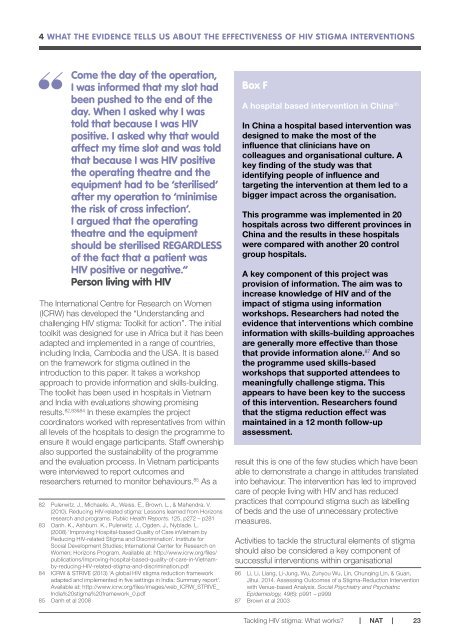Tackling HIV Stigma What works?
Jun_16_Tackling_HIV_Stigma
Jun_16_Tackling_HIV_Stigma
You also want an ePaper? Increase the reach of your titles
YUMPU automatically turns print PDFs into web optimized ePapers that Google loves.
4 WHAT THE EVIDENCE TELLS US ABOUT THE EFFECTIVENESS OF <strong>HIV</strong> STIGMA INTERVENTIONS<br />
Come the day of the operation,<br />
I was informed that my slot had<br />
been pushed to the end of the<br />
day. When I asked why I was<br />
told that because I was <strong>HIV</strong><br />
positive. I asked why that would<br />
affect my time slot and was told<br />
that because I was <strong>HIV</strong> positive<br />
the operating theatre and the<br />
equipment had to be ‘sterilised’<br />
after my operation to ‘minimise<br />
the risk of cross infection’. <br />
I argued that the operating<br />
theatre and the equipment<br />
should be sterilised REGARDLESS<br />
of the fact that a patient was<br />
<strong>HIV</strong> positive or negative.”<br />
Person living with <strong>HIV</strong><br />
The International Centre for Research on Women<br />
(ICRW) has developed the “Understanding and<br />
challenging <strong>HIV</strong> stigma: Toolkit for action”. The initial<br />
toolkit was designed for use in Africa but it has been<br />
adapted and implemented in a range of countries,<br />
including India, Cambodia and the USA. It is based<br />
on the framework for stigma outlined in the<br />
introduction to this paper. It takes a <strong>works</strong>hop<br />
approach to provide information and skills-building.<br />
The toolkit has been used in hospitals in Vietnam<br />
and India with evaluations showing promising<br />
results. 82,83&84 In these examples the project<br />
coordinators worked with representatives from within<br />
all levels of the hospitals to design the programme to<br />
ensure it would engage participants. Staff ownership<br />
also supported the sustainability of the programme<br />
and the evaluation process. In Vietnam participants<br />
were interviewed to report outcomes and<br />
researchers returned to monitor behaviours. 85 As a<br />
82 Pulerwitz. J., Michaelis. A., Weiss. E., Brown. L., & Mahendra. V.<br />
(2010). Reducing <strong>HIV</strong>-related stigma: Lessons learned from Horizons<br />
research and programs. Public Health Reports. 125, p272 – p281<br />
83 Oanh. K., Ashburn. K., Pulerwitz. J., Ogden. J., Nyblade. L.<br />
(2008) ‘Improving Hospital-based Quality of Care inVietnam by<br />
Reducing <strong>HIV</strong>-related <strong>Stigma</strong> and Discrimination’. Institute for<br />
Social Development Studies; International Center for Research on<br />
Women; Horizons Program. Available at: http://www.icrw.org/files/<br />
publications/Improving-hospital-based-quality-of-care-in-Vietnamby-reducing-<strong>HIV</strong>-related-stigma-and-discrimination.pdf<br />
84 ICRW & STRIVE (2013) ‘A global <strong>HIV</strong> stigma reduction framework<br />
adapted and implemented in five settings in India: Summary report’.<br />
Available at: http://www.icrw.org/files/images/web_ICRW_STRIVE_<br />
India%20stigma%20framework_0.pdf<br />
85 Oanh et al 2008<br />
Box F<br />
A hospital based intervention in China 86<br />
In China a hospital based intervention was<br />
designed to make the most of the<br />
influence that clinicians have on<br />
colleagues and organisational culture. A<br />
key finding of the study was that<br />
identifying people of influence and<br />
targeting the intervention at them led to a<br />
bigger impact across the organisation.<br />
This programme was implemented in 20<br />
hospitals across two different provinces in<br />
China and the results in these hospitals<br />
were compared with another 20 control<br />
group hospitals.<br />
A key component of this project was<br />
provision of information. The aim was to<br />
increase knowledge of <strong>HIV</strong> and of the<br />
impact of stigma using information<br />
<strong>works</strong>hops. Researchers had noted the<br />
evidence that interventions which combine<br />
information with skills-building approaches<br />
are generally more effective than those<br />
that provide information alone. 87 And so<br />
the programme used skills-based<br />
<strong>works</strong>hops that supported attendees to<br />
meaningfully challenge stigma. This<br />
appears to have been key to the success<br />
of this intervention. Researchers found<br />
that the stigma reduction effect was<br />
maintained in a 12 month follow-up<br />
assessment.<br />
result this is one of the few studies which have been<br />
able to demonstrate a change in attitudes translated<br />
into behaviour. The intervention has led to improved<br />
care of people living with <strong>HIV</strong> and has reduced<br />
practices that compound stigma such as labelling<br />
of beds and the use of unnecessary protective<br />
measures.<br />
Activities to tackle the structural elements of stigma<br />
should also be considered a key component of<br />
successful interventions within organisational<br />
86 Li, Li, Liang, Li-Jung, Wu, Zunyou Wu, Lin, Chunqing Lin, & Guan,<br />
Jihui. 2014. Assessing Outcomes of a <strong>Stigma</strong>-Reduction Intervention<br />
with Venue-based Analysis. Social Psychiatry and Psychiatric<br />
Epidemiology, 49(6): p991 – p999<br />
87 Brown et al 2003<br />
<strong>Tackling</strong> <strong>HIV</strong> stigma: <strong>What</strong> <strong>works</strong>? NAT 23


